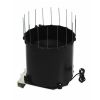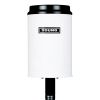Onset HOBO Pendant Event Data Logger
Features
- Records tips or momentary contact closures and temperature
- Event-based data storage provides detailed data and efficient memory usage
- Stores over 16,000 tips (160 in. of rainfall with a 0.01 in. rain gauge)
- Expedited repair and warranty service
- Lifetime technical support
- More
Overview
The Onset HOBO Pendant Event Data Logger accurately measures rainfall. The event logger determines rainfall rates, times, and duration after deployment with most standard tipping-bucket rain gauges. Efficiently gather and store momentary contact events and temperature data.
Event Data
Gain access to detailed event data with the Onset HOBO Pendant Event Data Logger accurately measures rainfall. The event logger determines rainfall rates and time. Event data is only stored when it happens for better memory usage. Use a solar radiation shield for accurate temperature measurement in sunlight applications. See RS1 Solar Radiation Shield (assembly required) and M-RSA (pre-assembled) Solar Radiation Shield.
External Event Input
Event sensor: Two-wire interface suitable for measuring mechanical and electrical contact closures
Maximum input frequency: 1 Hz (1 pulse per second)
Lockout time: 500 ms
Minimum pulse width: 1 ms (hardware debounce)
Input/output impedance: 100 kΩ
Edge detection: Falling edge, contact closure, or Schmitt-trigger buffer
Preferred switch type: Normally open. For maximum battery life, the event input should be used with its preferred switch type. The logger will work with normally closed switches, but battery life will be compromised.
Open circuit input voltage: Battery voltage; nominally 3.0 V
Maximum input voltage: Battery voltage + 0.3 V
User connection: 24 AWG, 2 leads: white (+), black (-)
Temperature Measurement
Measurement range: -20° to 70°C (-4° to 158°F)
Accuracy: ± 0.53°C from 0° to 50°C (± 0.95°F from 32° to 122°F), see Plot A. A solar radiation shield is required for accurate temperature measurements in sunlight.
Resolution: 0.14°C at 25°C (0.25°F at 77°F), see Plot A
Drift: Less than 0.1°C/year (0.2°F/year)
Response time: Airflow of 2 m/s (4.4 mph): 10 minutes, typical to 90%
Logger
Time accuracy: ± 1 minute per month at 25°C (77°F), see Plot B
Operating range: -20° to 70°C (-4° to 158°F)
Environmental rating: Tested to NEMA 6 and IP67; suitable for deployment outdoors
Drop specification: 1.5 m (5 ft) onto concrete
NIST traceable certification: Available for temperature only at additional charge; temperature range -20° to 70°C (-4° to 158°F)
Battery: CR-2032 3V lithium battery; 1 year typical use
Memory: 64K bytes
Materials: Polypropylene case; stainless steel screws; Buna-N o-ring; PVC cable insulation
Weight: 50 g (1.7 oz.)
Dimensions: 71 x 33 x 23 mm (2.8 x 1.3 x 0.9 inches); 1.8 m (6 ft) cable
- HOBO Pendant Event Data Logger
- Tie wraps
- Adhesive mount
In The News
Data-Driven Advocacy on the Lower Deschutes River
Like many freshwater environments, the Deschutes River in Oregon is under pressure from development, pollution, and climate change. Many rivers, streams and lakes in the Deschutes Basin do not meet Oregon water quality standards –where state water quality monitoring assesses levels of bacteria, pH, dissolved oxygen, temperature, and fine sediment. Hannah Camel is the Water Quality Coordinator for the Deschutes River Alliance (DRA), a non-profit organization that focuses on the health of the lower 100 miles of the Deschutes River–the area most affected by human intervention. As a data-driven organization, the DRA has benefited from the installation of two NexSens X2 data loggers.
Read MoreExpanding the Port Everglades: Real-Time Monitoring of Water Quality Conditions from Planned Dredging Operation
The Port Everglades in Broward County, Florida, serves large trade vessels and cruiseliners and incoming and outgoing recreational boaters. However, as cargo ships become larger, the port must expand. A dredging project led by the US Army Corps of Engineers will substantially deepen and widen the port's navigation channel to accommodate larger Panamax cargo ships and modern cruise liners. As a result of this project, a large amount of sediment will be displaced into the water column. This suspended sediment may settle outside of the project area, burying benthic organisms like corals, and possibly carrying harmful particulates to other regions. [caption id="attachment_39497" align="aligncenter" width="2560"] A CB-950 and CB-25 deployed on site at Port Everglades.
Read MoreIt’s Time to React to Water Quality: Proteus Multiparameter Probe aboard NexSens Buoy
Water quality monitoring is essential for safeguarding public health, protecting ecosystems, and ensuring the sustainability of water resources. Contaminants such as industrial pollutants, agricultural runoff, and sewage discharge can severely impact aquatic life and pose serious risks to human health if left unchecked. Traditionally, water quality monitoring has been a slow and labor-intensive process, requiring samples to be collected, transported to a lab, and analyzed—a process that can take days. However, with the advancement of real-time sensor technology, environmental agencies, researchers, and industries can now monitor water quality instantly.
Read More
















